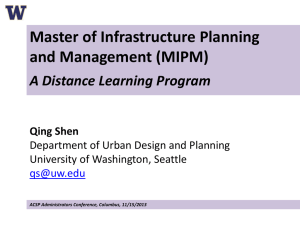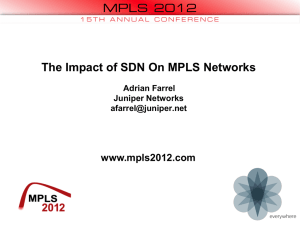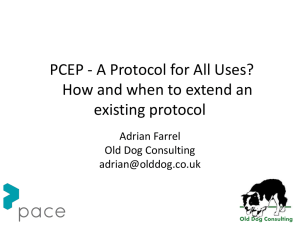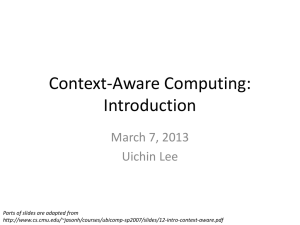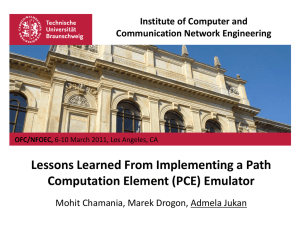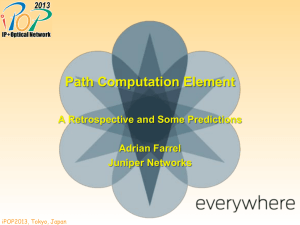Context-Aware PCE
advertisement
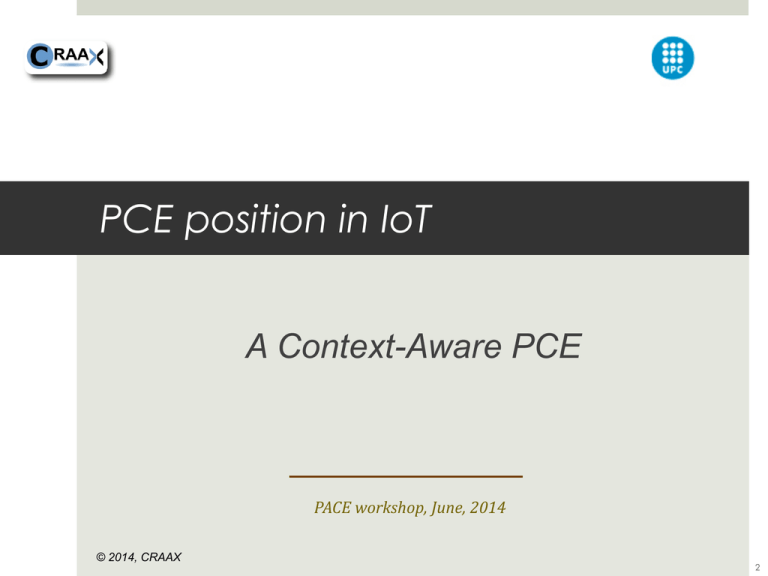
PCE position in IoT A Context-Aware PCE PACE workshop, June, 2014 © 2014, CRAAX 2 Objectives Positioning the Path Computation Element (PCE) in an Internet of Things (IoT) scenario. Describing the synergy between PCE, ID/LOC Split Architectures (ILSAs). Introducing the Context-Aware PCE. novel concept of 3 Methodology for a Context-Aware PCE A PCE endpoint might be attached to an ID. The mapping between an ID to a locator(s) is done according to a given context. 4 Challenges for a Context-Aware PCE Enable interaction between a PCE and a ILSA scheme Enhance current PCEP in order to support both context-information and IDs based endpoints Defining reconfigurable recovery actions 5 Context-Aware PCE The driver of an IP/Optical connection is not a location,….. An interest, also called ”thing” (something that a node can provide) motivates an IP/Optical connection ,… An interest is defined within a context 6 Context-Aware PCE The conventional model of host-oriented connections does not fare well in multi-domain and large-scale network scenarios where mobility features are enabled (mobility of both hosts and data). Consider Cloud and OpenData environments using optical transport technologies in order to cope their bandwidth-hungry requirements. Network research community foresee in the coming years the demise of host-oriented communication models. This is noticeable by the recent studies already available related to new internet architectures, many of them relying on a information-centric or context-aware internet models [1]. The aforementioned bullets motivated us to introduce the novel concept of Context-Aware PCE. 7 Context-Aware PCE Contrary to a conventional PCE where endpoints of a PCReq are location dependent, i.e., Host-Oriented PCE, in a Context-Aware PCE scenario endpoints are contextdependents. To this end, interaction between a PCE and an ILSA scheme is required. The rationale behind ILSA schemes is to decouple the application layer from endpoints location. This new communication model is commonly known as informationcentric or context-aware networking This communication model can be adopted in PCE scenarios by coupling PCReq endpoints to IDs. 8 Context-Aware PCE Path Computation Clients (PCCs ) similar to the application layer are only interested to make a connection to a certain endpoint or content no matter its location. The relevant in a context-aware communication model is the “What” (“connection to something”) rather than the “Where” (“connection to a location”). The identity of an endpoint depends of some given context, e.g., location, time, traffic volume, etc. Thus, a connection holding time and the network recourses allocated to it might vary according to the PCC interest. A context-aware PCE paves the way to traffic-oriented, energy-oriented, resilient communications among others. 9 Context-Aware PCE In the use-cases presented in the slides 11-14 a PCReq end-point is coupled to an ID. An ID is an abstract object that is not physically attached to a device , e.g., Wavelength Router (WR) or IP/MPLS router). An ID might represent a collection of devices with a common feature, e.g., data repositories GIS providers WRs within a Data Center. An ID is mapped to a locator (an address attached to a device), according to a given context, e.g., trending topic measured at different time-scales. The entity in charge of the mapping process is an ILSA scheme. An PCEP object is enhanced with the parameters IDs and Connection-Context. 10 Traffic-Oriented Communication TED Two cross-layer connection associated to LSP A-B and one to LSP-A-C. PCC’s policy is to allocate more network resources All cross-layer to the current Treding-Topic connections associated to LSP A-C ContextAware PCE •ID Data-Repo is mapped to a locator belonging to the domain related to the given context (trending topic in this case) Contextparameter: restaurants High volume of queries related to keywords: football match, Barcelona vs. Madrid Time 18:00 20:00 PCReq for LSP A-Data-Repo Context-Aware connections PCReq-Update Enhanced PCEP object Source: Locator A. Destination: ID Data-Repo Connection-Context: TrendingTopic Context-Parameter: Football Bandwidth: …. Metric: …. Football match over, queries related to keywords: restaurant, dinner, Barcelona Optical PCE VNTM Traffic-Oriented Communication TED In this scenario, we skip the steps for setting-up the LSPs. We intend to show a scenario in which LSPs are established with trending-topic as the Connection-Context. The ContextParameter is updated daily Monday: Saturday: Increase Decrease number number of Transponders of Transponders associated associated to to this this link link Monday: Decrease Saturday: Increase number of Transponders associated to this link Context-Aware connections Optical PCE Context-Aware VNTM PCE Use-Case: Energy-Oriented Communication TED •ID GIS mapped to a locator belonging to the GIS Provider using the sun as its main energy-source Enhanced PCEP object Source: Locator A. Destination: ID GIS Connection-Context: Energy In this scenario, we do not show how theSource ILSA scheme knows which GIS provider (domainContext-Parameter: 1 or Sun 2) is powered by sun-energy. A synchronization Bandwidth:…. process might be required. Metric: …. PCReq for LSP A-GIS Context-Aware connection ContextAware PCE Optical PCE VNTM Time 24:00 12:00 Time 24:00 12:00 PCReq-Update 13 Resilient Communication In this scenario, router C is the primary router and router B is a backup router. No Context parameter is used. However, an ID is used as an end-point. TED Optical PCE ContextAware PCE VNTM •Map ID (X) to locators C, and B Due to the failure on router B, a protection action triggers the provisioning of router D as the backup router for router C D PCReq for both primary and backup LSP A-X 14 Context-Aware PCE It is not unrealistic to assume a periodic and highly dynamic behavior regarding trending-topics and internet traffic, as shown on slides 11-12. 15 16 Context-Aware PCE Notice that search topics regularly follow a periodic behavior. with a Period time= 7days. Data extracted from [1]. Context-Aware PCE The figure shown in this slide depicts the Queries distribution (daily) between June-September (2013) in Barcelona (Relative Values), extracted from [2]. Certain search topics such as movie theaters exhibit a drastic increase during weekends. The opposite occurs with search topics such as banks) This drives us to encourage the practice of dynamical allocation of network resources dedicated to a connection between an Information Asset Provider (IAP) such as a GIS provider or a Data Repositories, and an Open Data Stakeholder ODS), e.g., the domain owner of a OpenData Middleware). The x axis is the accumulative for three days of a month, i .e., Monday=Data of three Mondays for June-September 17 Context-Aware Graph There is an increasing deployment of smart devices (sensors, open data gathering servers, etc), coining the so-called Smart Cities –a concept encompassed by the IoT. Consequently, City councils are encouraging the developing of new internet applications that exploit Smart City services. Upon the composition of a smart-service, i.e., a service that collects information from several data sources, physical connectivity to the data sources must be established. Traditionally, both service composition and path computation have been two processes independently from each other. Our intention is to combine Apps devoted to service composition and a context-aware PCE scheme into a collaborative ecosystem, where a context-aware PCE computes a path based on both the context-aware Graph and Transport Network Graph. 18 Context-Aware Graph Path Cost Improvement Increase the set of candidate paths for a given end-point pair. More candidate paths -> Higher reliability. Enable Interoperability between distinct network protocols, e.g., IPv4, IPv6. Evaluation with regard to the Path Cost Improvement have been done assuming distributed source-based routing [3]. But there is not any study assessing the Path Cost improvement in centralized path computation architectures such as PCE. 20 Conventional Path Computation in a multi-network protocol scenario Only one candidate path to destination D. Path Computation Improvement in a multi-network protocol scenario Dest:D,Label 2 Dest:3, Label 1 Three candidate paths to destination D. Dest :D,Label 2 Dest: D Label 2 ID D: Mapped to LOCs D or 3,





